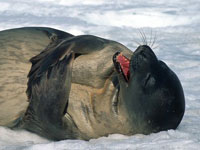Arctic seal Sahara prefers warm waters
The Arctic seal Sahara always swims back in warmer waters.

The young seal was rescued off the coast of Africa last year, far from his native habitat in the Arctic circle. He was brought to Britain to be nursed back to health and was freed into the wild - only to paddle in the wrong direction again.
Animal rights activists now hope to give Sahara one more chance to fix his radar - or else.
"We're disappointed that he headed south and not back up north," said Tamara Cooper, an animal care supervisor at the National Seal Sanctuary in southern England. "But we're relieved that he's safe and well."
The rescue drama began last year for Sahara, a type of Arctic seal known as a hooded seal, which has an inflatable bulge that sits on the nose of the adult male. He was only a few months old when he washed up on the shore of Morocco - far from the normal migratory zone of a loner animal that mates near Iceland and Greenland.
Weak and probably sick, he looked a bit worse for wear, having lost his fur coat, Cooper told The Associated Press on Thursday.
"We think he left a breeding area in Iceland and got completely lost and followed the shelf down to Morocco," she said. "He hadn't learned to feed himself and he became weak."
From there, Sahara was taken to Loro Parque, an animal park in Tenerife, one of the Canary Islands in Spain, Cooper said. There, he was named Sahara, apparently because he had been found near the Sahara Desert.
But Loro Parque didn't have the type of seals that Sahara needed to socialize with and learn vital skills, such as competing for fish, Cooper said. So in April, he was flown to the National Seal Sanctuary in southern England.
"He learned to fight for his fish, lost a lot of tubby weight and put on some muscle, which was just what we wanted," she said.
The sanctuary attached a satellite tag to Sahara's neck, drove him to northern Scotland and released him Oct. 10 from a boat about six kilometers (four miles) off the Orkney Isles.
Sahara first headed toward Iceland, but when the sea became more shallow he followed the shelf all the way to Spain.
He was found Sunday in the bay of Ondarroa, 75 kilometers (45 miles) east of the industrial port city of Bilbao, and was filmed by the Basque television station etb.
From Ondarroa, Sahara was taken to a rescue facility in San Sabastian, Spain, where his health is being checked, Cooper said.
In the last 10 years, she said, some hooded seals have begun heading far south of the Arctic, leaving scientists wondering why and leading to theories that they may be following ocean currents or fish movements. But no one knows what keeps driving Sahara south.
Cooper dismissed suggestions that seals like Sahara just like warmer waters, saying hooded seals have very thick blubber.
"They shouldn't even feel the cold," she said.
The seal rescuers will decide later what to do next about Sahara.
"We hope he gets one more chance to remain free, instead of being protected here," Cooper said.
Subscribe to Pravda.Ru Telegram channel, Facebook, RSS!


